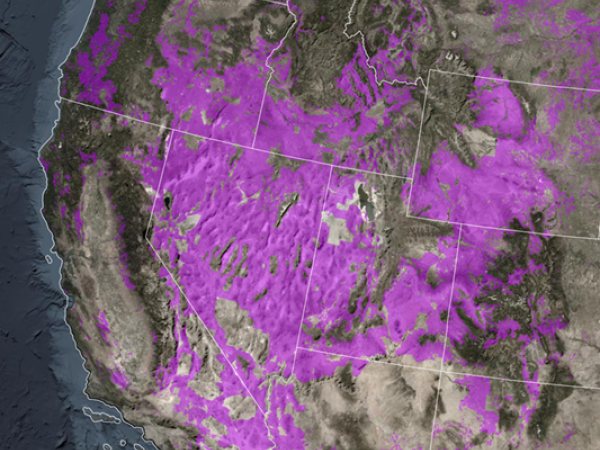Journey North Data In Action: Modeling for Land Use
Using Monarch Observation Records to Support Federal Land Management
We’re all aware that the population of monarchs in North American has declined precipitously in recent decades. In response, land managers have made numerous actions, such as planting milkweed, with the goal of reversing this trend. In the West, the Bureau of Land Management (BLM) manages more land than any other federal agency, and thus has an outsized responsibility for the conservation of monarchs in that part of the country.
Recognizing their importance to monarch conservation, the BLM contacted NatureServe, a science-based biodiversity nonprofit, in 2021 to help better understand monarch distribution patterns in preparation for developing a strategy for the conservation of monarchs and other pollinators on the land that the agency manages. To do so, NatureServe scientists focused on the migration pathways taken by monarchs, a topic poorly understood for western monarchs.
The major features of the life cycle of monarchs living west of the Rocky Mountains are broadly known. In the fall, most individuals migrate to the California coast and overwinter in scattered aggregations. In the spring, the population expands outward from the overwintering sites through a multigenerational migration, much as eastern monarchs expand northward from their Mexican overwintering site.
In contrast to the East where a moist climate supports the potential growth of milkweed, the monarch host plant, widely, the generally drier climates of the West present much more limited opportunities for milkweed to grow. Similarly, the fall flowering plants that provide nectar that migrating monarchs use to fuel their flight to the California coast are also limited in the places where they can grow. Areas in or near wetlands and along streams and rivers, as well as irrigated suburban gardens and agricultural fields are the best places to find milkweeds and fall nectar plants.
NatureServe used these natural history characteristics to build mathematical models that predicted where the habitat would be most suitable for monarchs during different stages of their migration. The models required two kinds of input. First, they need the localities where monarchs are known to occur. Second, they need to know the habitat features of the places where monarchs occur. These features include climate, soils, topography, vegetation type, and the existence of wetlands or rivers. The model associates the locations where monarchs have been found with the suite of habitat features at these locations to then predict other places where these habitat features cooccur and therefore likely also host monarchs.
For the spring models, NatureServe included information about the presence of milkweed, which is vital to the development of each generation of monarchs as they spread outward from their overwintering grounds. The fall models included information about the distribution of plants that flower in the fall and are known to be visited by migrating monarchs. Using this information in the models helped make them more realistic and therefore provided greater confidence in the accuracy of their outputs.
For monarch occurrence records, the first input into the models, NatureServe turned to citizen science records such as those submitted through Journey North. Thankfully, dedicated volunteers have submitted observations of monarchs from across much of their range in the West. We compiled a total of 16,490 unique records from the spring and fall migratory periods during the period 2010-2021.
The resulting models predicted areas where the habitat is most favorable to migrating monarchs. The results showed that the Central Valley of California, the Snake River in Idaho, the foothills of the Rocky Mountains in northern Utah, and the coastal counties of southern California are especially important areas for migrants in both the spring and fall. Numerous other areas across the West also have favorable habitat in either the spring or fall, demonstrating the broad geographical area over which monarch conservation is needed.
Armed with these results, BLM can now refine its pollinator strategy. Natural resource managers in each BLM field office now know where to dedicate efforts to protecting and enhancing monarch habitat. These actions may involve planting milkweed and fall-blooming flowers or erecting fencing in riparian areas to prevent livestock from trampling habitat. They may also steer proposals for oil and gas drilling or solar farm installations away from prime habitat for monarchs.
Considering the vast areas of the western monarch’s range under BLM management, this research project has the potential to catalyze significant conservation actions. The BLM has also shared the results with the US Fish & Wildlife Service, which also manages western monarch habitats, especially near wetlands. With this fine scale information on the locations of habitats that are most important to monarchs, the conservation community can better target monarch habitat restoration and enhancement activities to where they will benefit the most individuals.
---
Bruce E. Young is the Chief Zoologist and Interim Chief Scientist with NatureServe, a U.S. - based nonprofit organization made up of passionate biodiversity scientists who want to apply the best information to decision-making. To protect threatened biodiversity, NatureServe works with over 60 network organizations and over 1,000 conservation scientists to collect, aggregate, and standardize biodiversity statistics, providing comprehensive data to the public for strategic conservation efforts. For over 50 years, NatureServe and the NatureServe Network have worked together to develop and manage the most comprehensive data for over 100,000 species and ecosystems.



